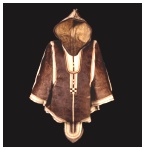
 Want to Stay Warm? Try a Caribou Suit When the Inuit lived exclusively from the land, caribou and seals were the main sources of clothing material. Both provided protection from the harsh Arctic winters. No part of an animal was wasted. Caribou provided meat and the skin was the best material for making winter clothing because it is very warm. The hair growth is about twice as dense as that on seal skin, and the hollow guard hairs enclose air, providing a high level of insulation against the cold. Traditional Inuit clothing for the coldest weather consisted of two layers of garments. The inner one had the fur against the skin, the outer one had the fur outside. Not only does the hollow fur itself provide an insulating layer, but the two layers of clothing trap an insulating layer of air between them. Of course, caribou skin was usually one of the few materials available. The textiles that became available from the European's were not considered by the Inuit to be at all suitable for winter wear - you'd have to put on layers and layers and layers of clothing and you'd STILL be cold!
Click pictures for more information and credits. Library: Arctic, Inuit, Animals, Land Links: Arctic, Inuit, Animals Maps: Nunavut Arctic Maps & Weather Reports |

|
DICTIONARY: Just "double-click" any unlinked word on this page for the definition from Merriam-Webster's Student Electronic Dictionary at Word Central. |

|
ARCTIC LIBRARY & GLOSSARY: Check this section for an index of the rest of the things you really need to know about the Arctic. |

|
ARCTIC MAPS & WEATHER REPORTS: Maps of the Northwest Passage, explorers' routes, iceberg sources, Nunavut, the Arctic by treeline, temperature... |

|
ARCTIC LINKS: Even more information! Links to sites related to the Arctic and "Iceberg: the Story of the Throps and the Squallhoots". |

|
GUIDE TO ARCTIC SUNRISE & SUNSET: How much sunlight or darkness is there in the Arctic on each day of the year? |
to is the property of their respective owners, and Athropolis is not responsible for their content.